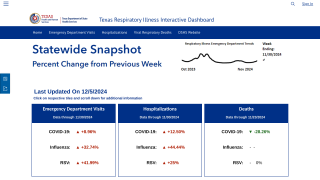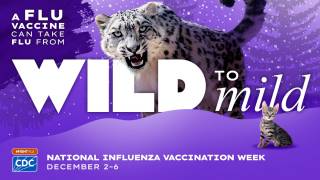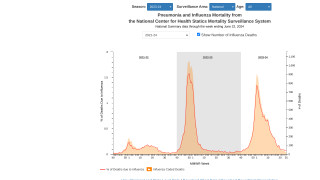Texas Reports 1st Pediatric Fatality This Flu Season

Influenza activity is increasing and has exceeded the Texas-specific influenza-like illness (ILI) baseline for the first time this flu season, reported the Department of State Health Services (DSHS).
This Texas DSHS report published on November 15, 2019, also includes news of the 1st influenza-related pediatric fatality in the state of Texas this season.
During the 2018-2019 influenza season, the DSHS confirmed 17 influenza-associated pediatric fatalities in Texas.
Throughout the USA, the Centers for Disease Control and Prevention (CDC) has confirmed a total of 3 influenza-associated pediatric fatalities occurring during the 2019-2020 season.
One fatality was associated with an influenza A virus, for which no subtyping was performed and occurred the week ending February 16, 2019, in the 2018-2019 season.
This new information increases the total number of fatalities during the last flu season to 143 children in the USA.
During the 2017-2018 flu season, the CDC confirmed a total of 187 pediatric fatalities.
"Be very careful if you get the flu, as you can pass it on to someone with a weak immune system that can really become sick. Getting a flu shot not only protects yourself but also those you love," said Crockett Tidwell RPh, CDE, United Supermarkets Pharmacy.
An influenza-associated pediatric death is defined for surveillance purposes as a death resulting from a clinically compatible illness that was confirmed to be influenza by an appropriate laboratory diagnostic test.
During week 45, data collected in ILINet showed the following ILI activity levels throughout the USA:
- High – Louisiana
- Moderate – Puerto Rico and Alabama, Georgia, Mississippi, South Carolina, and Texas
- Low – Arizona, Arkansas, Connecticut, Missouri, Nevada, New Mexico, Oklahoma, Tennessee, and Virginia
- Minimal – the District of Columbia, New York City, and 35 states (Alaska, California, Colorado, Delaware, Florida, Hawaii, Idaho, Illinois, Indiana, Iowa, Kansas, Kentucky, Maine, Maryland, Massachusetts, Michigan, Minnesota, Montana, Nebraska, New Hampshire, New Jersey, New York, North Carolina, North Dakota, Ohio, Oregon, Pennsylvania, Rhode Island, South Dakota, Utah, Vermont, Washington, West Virginia, Wisconsin and Wyoming)
- Data were insufficient to calculate an ILI activity level from the U.S. Virgin Islands.
Nationally influenza B/Victoria viruses have been reported more frequently than other influenza viruses this season, however, influenza A(H3N2) and A(H1N1)pdm09 viruses are also circulating widely.
Nationally, influenza B/Victoria viruses are the most commonly reported influenza viruses among children age 0-4 years (45% of reported viruses) and 5-24 years (53% of reported viruses), while A(H3N2) viruses are the most commonly reported influenza viruses among persons 65 years of age and older (72% of reported viruses).
Among adults aged 25-64 years, approximately equal proportions of influenza A(H1N1)pdm09, A(H3N2) and B/Victoria viruses (31%, 30%, and 26%, respectively) have been reported to the CDC.
Most people who get sick with flu will have a mild illness, will not need medical care or antiviral drugs and will recover in less than 2 weeks. Some people, however, are more likely to get flu complications that can result in hospitalization and sometimes death, says the CDC.
> Click here for a flu test from UltaLabs <
Flu vaccination is always the best way to prevent flu and its potentially serious complications.
Furthermore, pregnant women remain the highest priority group for annual influenza vaccination, and a new study adds more evidence to that focus.
This new study published on November 11th in England found that when pregnant women receive an influenza vaccination, their future infants experience a reduced number of flu cases and related hospitalizations prior to reaching 6 months of age.
Also, getting vaccinated can help protect a baby after birth from flu, as the mother passes protective antibodies onto the developing baby during her pregnancy, says the CDC.
Most flu vaccines protect against 4 different influenza viruses for the 2019-2020 Northern Hemisphere season.
The CDC also suggests pregnant women get a flu shot and not the nasal spray influenza vaccine for the current flu season. The nasal spray flu vaccine is approved for use in non-pregnant individuals, 2 years through 49 years of age.
But, people with some certain medical conditions should not receive the nasal spray flu vaccine.
As always, vaccination decisions should be part of an ongoing discussion between a provider and patient.
Previously, the American Lung Association and the American Diabetes Association joined the American Heart Association on October 16, 2019, ‘urging 117 million adults living with chronic health conditions, including diabetes, heart disease, and lung diseases to prioritize annual flu shots within their practices.’
Influenza news published by Precision Vaccinations
Our Trust Standards: Medical Advisory Committee


























